
Vol. X, No. 3, October-December 2011
Making the Most of Foliage
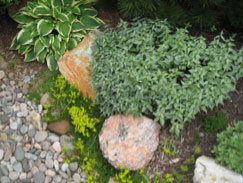
Now that the winter winds are howling and snow may be in the air, I would like to talk about how to use plant materials in a children’s play garden by using examples from my own garden. Our garden is now five years old and a fairly small space as gardens go. The small space has taught me how to make careful plant selections for both color and visual interest. The small space has also taught me how to make furniture selections that are flexible. This garden has now reached the level of maturity that you would expect to see reflected on landscape plans. This knowledge should help you to understand why you need to specify large plant materials or the children will be in grade school or even college by the time the plant matures.
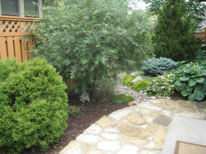
Children are sensory driven so the visual impression of plants can help children understand the variety of textures among natural materials. The smoothness of the river rock encourages children to roll them over and take a peek at what is underneath. The larger jagged rocks provide a different experience both visually and texturally. The finely and medium textured ground covers provide sensory input and visual stimulation. The variety of surfacing is visually appealing.
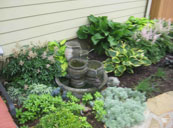
Children go outside most days in the winter so provide plants that have seasonal interest. The different types of evergreens shown here provide both texture and a structure to the garden in the winter when other plants have shed their leaves.
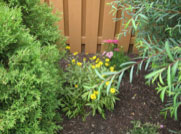
The plants around the water feature in this photo show a variety of different colors and textures. Even the red plant in the right lower corner adds new visual interest. Plants can be chosen that do not attract bees and grow in a variety of conditions, shade or sun. Water is always of interest to children so be sure to incorporate a water feature in your garden. This water feature is my favorite place in the garden.
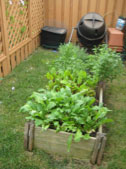
Different plant colors can used to add a splash of color around the garden. Be sure to choose perennials that don’t require too much water and are native to your geographic area.
Raised garden beds made of untreated cedar and filled with a variety of herbs will add visual and olfactory stimulation. If you are worried about bees just be sure to keep the herbs from blooming. Children will love to give them a “haircut”. The use of a composter means that you can teach children the concept of recycling and giving back to Mother Earth. Compost will work great in your raised beds and it will be organic.
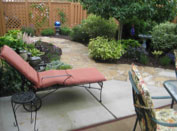
Variegated or plants that use white in their leaves can add brightness by reflecting light. Be sure that all plants parts are checked for poisonous parts, including stems, leaves, flowers, roots, bark and seedpods.
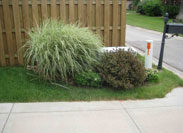
Camouflage is best described as a way of concealing something in the environment to make it less noticeable, by blending it in with its surrounding environment. Plants can be used to hide unsightly features in the play yard. However, just because it is hidden with plants doesn’t mean that children will not use this area. Make sure that all utility boxes, pump boxes, grates, phone lines, outdoor air conditioning units, etc. are locked and totally inaccessible to inquisitive children.
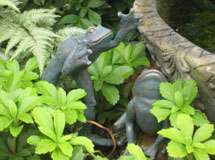
Outdoor environments and gardens are a great place to add unexpected, fanciful or whimsical items. Just make sure that they are well grounded and stable so that children do not move the items around and that they are out of the pathways of foot traffic. The small frogs shown here are playing next to the water feature, safely nestled in the groundcover.
Hopefully this garden log will remind you to choose someone to design your outdoor play space that has both gardening experience and plant knowledge.
